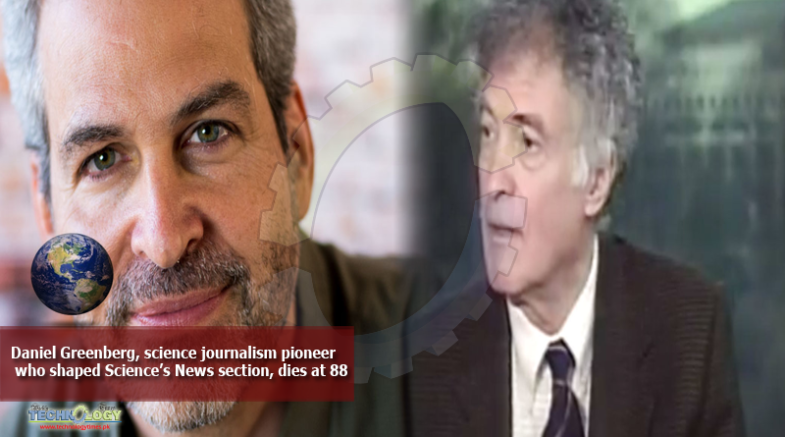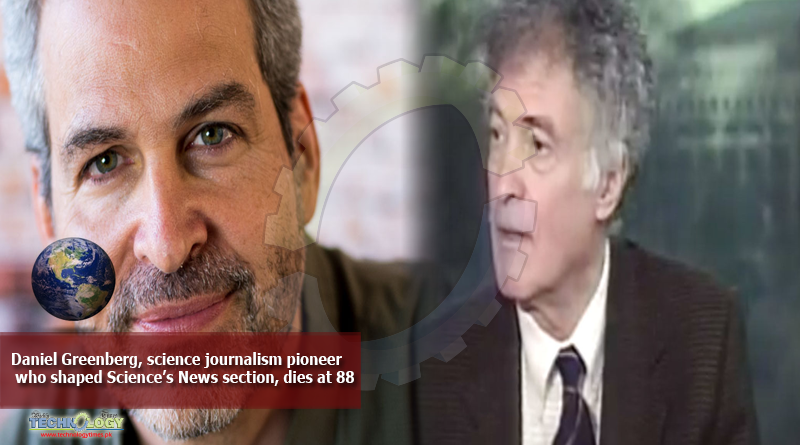Daniel Greenberg, a journalist who pioneered coverage of the intersection of science and politics and was an influential early leader of Science’s News section, died on 9 March at his home in Washington, D.C., at the age of 88. Greenberg had been in ill health since sustaining a fall in late December 2019, according to The New York Times.

In 1961, Greenberg became the second journalist hired by Science to “cover political events that involved science,” he recalled during an interview in 1986. “I had never heard of Science magazine before that, and we decided we’d try each other out for a month and see how we liked it.” Howard Margolis, a journalist who had established the News section, left soon after Greenberg arrived. “So, I was there by myself,” he recalled. He became the section’s editor and lead reporter, and “stayed for 10 years.”
During that period, Greenberg helped pioneer coverage of the federal government’s burgeoning research enterprise—especially the National Institutes of Health (NIH)—and the often fierce policy debates over funding priorities and regulation of emerging technologies, such as supersonic passenger aircraft. Greenberg, who had worked in Congress as a congressional fellow of the American Political Science Association, brought to his reporting a sophisticated understanding of congressional machinations, as well as a somewhat skeptical view of the research community’s pleadings for funding and promises of breakthroughs. His reporting differed markedly from the boosterish, “gee-whiz” tone that typified much mainstream coverage of science at the time. Journalists who covered science were often good at translating discoveries to the public, Greenberg said in 1986, but “they will not usually concern themselves … with the social, economic, or moral implications, or … if [a] treatment were generally available it would raise the health bill of the country such and such.”
“Mr. Greenberg pretty well invented a new way to cover big science—as a form of government spending no different, in budgetary terms, from defense procurement or agricultural support,” The Economist wrote in 2002.
“Greenberg … more than any other man on Science has helped to build its circulation to an all-time high of 160,000,” The Washington Post reported when he left Science in 1970. “[H]e wrote and directed numerous exclusives on the science beat.”
Greenberg next founded the Science & Government Report, a newsletter that had an influence disproportionate to its subscription list, which never exceeded a few thousand. The newsletter was widely read by Washington, D.C., policymakers, university leaders, and journalists. Its coverage of institutional developments and congressional hearings often had an arch, bemused tone. Reporting on one Senate hearing on a complicated funding issue, Greenberg wrote that one senator appeared clueless, but “read reasonably well from a list of questions prepared by her staff.” At times, Greenberg mused on which member of the congressional spending panels that set NIH’s budget would be the next to have a building named after them on the agency’s campus in Bethesda, Maryland. Greenberg sold the newsletter in 1997, and it later ceased publishing.
For decades, Greenberg delighted many readers with his interviews of Dr. Grant Swinger, a fictional character he created when at Science. In a 1965 column, Swinger was introduced as head of the Breakthrough Institute, “a research establishment dedicated exclusively to fulfilling the public demand for scientific breakthroughs. We are the shock troops of science. … [W]e have been able to report to the public and granting agencies a broad variety of imminent breakthroughs.” Later, Swinger became the head of the Center for the Absorption of Federal Funds, and Greenberg collected his musings and advice in The Grant Swinger Papers, a 1983 book.
Greenberg also wrote more serious tomes, including The Politics of Pure Science, published in 1968, and Science for Sale: The perils, rewards, and delusions of campus capitalism, published in 2007.
Many leaders of the scientific community had a love-hate relationship with Greenberg. They winced when they were the targets of his writing, but they also consumed his work with gusto. Yesterday’s obituary of Greenberg in The New York Times closes with an anecdote that captures the respect that many Washington, D.C., insiders had for the journalist. “At a party marking the sale of [his newsletter] in 1997, a medical researcher gave Mr. Greenberg a book along with a letter saying the gift was ‘a token of my respect and admiration for you in the extraordinary job that you have done,’” reports Cornelia Dean, a former editor of The New York Times science section. “The letter was signed by Dr. Anthony S. Fauci, today the federal government’s top infectious diseases expert and the scientific face of the White House’s coronavirus task force.”
Courtesy: AAAS
